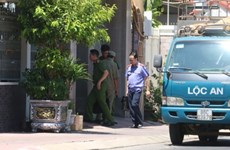Poverty reduction targets reached ahead of schedule
The national poverty rate stood at 11 percent in 2009, finishing the five year
target one year ahead of schedule.
The national poverty rate stood at 11 percent in 2009, finishing the five year
target one year ahead of schedule.
The Ministry of Labour, War Invalids and Social Affairs reported that some provinces and cities have virtually eliminated poverty based on the current national standard. The capital Hanoi , Danang City and Khanh Hoa province in the central region along with the southern economic hub of Ho Chi Minh City have raised the poverty line by two or three fold over the national standard.
The north-western mountainous region was the poorest with the poverty rate at almost 25 percent while the south-eastern region was dubbed “the richest” with a poverty rate as low as 3.6 percent.
Remote, mountainous regions and ethnic minority communities have been placed high up in the national poverty reduction programme over the last year. The programme disbursed some 8 trillion VND (432 million USD) in preferential credit for over 1 million poor families and provided training and the transfer of technology in agriculture, forestry and fisheries for nearly 700,000 poor and ethnic minority people.
With State budget allocations, local administrations have invested in over 700 infrastructure projects for villages rated as the poorest of the poor and those on alluvial soil along the coasts and on islands which are prone to natural disasters.
The funding has also helped to build houses for over 53,700 poor families, provided free medical insurance cards for over 12.5 million poor people and reduced or exempted tuition fees for 2.5 million disadvantaged students.
The Government’s resolution to quickly eradicate poverty in poor districts made a considerable contribution, reducing the poverty rate in the 62 poorest districts to 41 percent on average in 2009, down from 47 percent in 2008.
The poverty reduction programme targets for 2010 are less than 10 percent for the entire nation and under 40 percent for the country’s poorest districts./.
The Ministry of Labour, War Invalids and Social Affairs reported that some provinces and cities have virtually eliminated poverty based on the current national standard. The capital Hanoi , Danang City and Khanh Hoa province in the central region along with the southern economic hub of Ho Chi Minh City have raised the poverty line by two or three fold over the national standard.
The north-western mountainous region was the poorest with the poverty rate at almost 25 percent while the south-eastern region was dubbed “the richest” with a poverty rate as low as 3.6 percent.
Remote, mountainous regions and ethnic minority communities have been placed high up in the national poverty reduction programme over the last year. The programme disbursed some 8 trillion VND (432 million USD) in preferential credit for over 1 million poor families and provided training and the transfer of technology in agriculture, forestry and fisheries for nearly 700,000 poor and ethnic minority people.
With State budget allocations, local administrations have invested in over 700 infrastructure projects for villages rated as the poorest of the poor and those on alluvial soil along the coasts and on islands which are prone to natural disasters.
The funding has also helped to build houses for over 53,700 poor families, provided free medical insurance cards for over 12.5 million poor people and reduced or exempted tuition fees for 2.5 million disadvantaged students.
The Government’s resolution to quickly eradicate poverty in poor districts made a considerable contribution, reducing the poverty rate in the 62 poorest districts to 41 percent on average in 2009, down from 47 percent in 2008.
The poverty reduction programme targets for 2010 are less than 10 percent for the entire nation and under 40 percent for the country’s poorest districts./.













